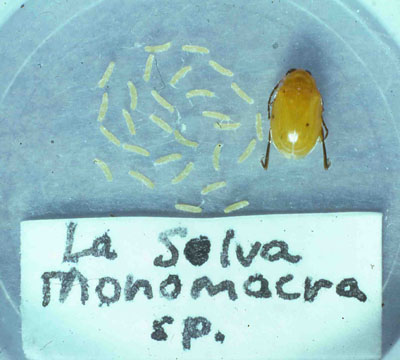Black-tibia Parchicola Flea Beetle (Parchicola "black tibia")
(Formerly part of Black-legged Yellow flea beetle (YBL); YBL formerly part of Yellow Monomacra species until 2011; divided into 2 species "YT" and "BT" February 2014)
The Black-tibia Parchicola flea beetle was discovered as a cryptic species using genetic "barcoding" analysis. This finding was the latest step in an long process of uncovering diversity within field collected "morphospecies" and highlights the importance of careful record-keeping and specimen curation. When I first discovered the flea beetles of Passiflora, I collected as many specimens as possible while recording their numbers on the plant. One morphospecies was bright yellow so I naturally designated it as YFB "yellow flea beetle". The specimens I glued on points and labelled them with host plant information. When I completed my thesis in 1978 I sent the collection to the United States National Museum (Smithsonian) to see if they could identify any of the genera or species. They returned the collection with the yellow specimens (now turned brown by aging) divided into two genera, Strabala and Monomacra. I used this collection to write the Smiley (1982) article. Years later when I picked up the project for the second time, I sent the flea beetles to the David Furth at the Smithsonian. He was able to modernize the generic names to Ptocadica and Parchicola, respectively. He also discerned that the yellow Parchicola category included two species, a black-legged form he called "DF1" and a yellow-legged form he called "DF2". I immediately began using these characters in my field notes and kept collecting flea beetles.
When I had enough fresh samples oreserved in alcohol, I sent material to Carlos Garcia at the Smithsonian, and he conducted the barcode analysis as described in the text. The results were quite clear; the black-legged species Pa. DF1 acually included 2 species (14 specimens of one species and 7 of the other). Reviewing my collection history and host plant origin of the sequenced individuals, I was able to associate one of the species with apparently larger individuals collected from P. vitifolia and P. quadrangularis. P. oerstedii, the most common Pa. DF1 host, was conspicuously absent from this group. To test the idea that the two beetles came from different host species, I collected 5 fresh individuals from P. vitifolia and 5 from P. oerstedii. As predicted, I found the P. vitifolia set to be longer (x=3.52mm; n=5) than the P. oerstedii set (x=3.22mm; n=5; p<0.02; t-test). However, what is more interesting is that I found all five P. vitifolia individuals to have solid black (or dark brown) hind tibia and all five P. oerstedii individuals to have yellow (unmelanized) hind tibia. When I examined my original 1978 collection I found this character to be preserved! I was easily able to sort pinned Parchicola DF1 specimens into two groups. Also, upon re-examination of the specimens used in the genetic analysis, I was able to confirm that the two species may be distinguished by the color of the hind tibia and that the species may be identified from this external, persistant morphological character.
Working backwards with known specimens I listed host plant occurrances for both species including many specimens collected in 1975-76. These can be seen in Table 2. Note that both P. "yellow tibia" and P. "black tibia" have been found on P. vitifolia, P. ambigua, P. quadrangularis and P. oerstedii, and both may also rarely be found on species of Decaloba such as P. auriculata.
The black-tibia species appears to be most common on P. vitifolia at La Selva. Perhaps it reproduces on that species, analogous to yellow-tibia reproducing on P. oerstedii. In August 2015, after an unusually intense rainy period lasting since June, this species was found commonly, including a group of five on one P. vitifolia shoot. I have also found black-tibia on P. ambigua and P. quadrangularis on several occasions.

Another closeup on P. ambigua showing the black tibia.